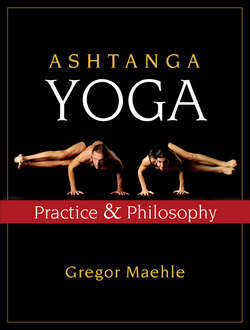Читать книгу Ashtanga Yoga - Gregor Maehle - Страница 29
На сайте Литреса книга снята с продажи.
Оглавление
Samasthiti
The front of the rib cage, the sternum, is lifted. (In common with many teachers, I will refer to this area as the heart.) One way of doing this pinches the shoulder blades (scapulae) together, which puffs the chest out as in a military posture of attention. This leads to a hardening and closing of the area behind the heart. Instead, as the heart is lifted, the area of the back behind the kidneys broadens and the shoulder blades widen and gently sink down the back. The shoulder blades flatten onto the back of the chest and support the elevated and open position of the heart area. The lower ribs in the front of the chest soften back in toward the body. The arms may need to be “looped”5 in the shoulder joint to reposition the head of the arm bone (humerus) so that it sits in the center of the shoulder joint. These actions leave the chest open and broad in all directions. The rib cage and lungs are free to expand, facilitating a full, free-flowing breath.
ANATOMICAL FOCUS
Inner Integrity
The bony vertebrae of the spine house the spinal cord, and its nerve ends exit between each vertebral body. The strong outer form of every posture supports the spine, enabling it to be fluid and extend freely. The nervous system remains unimpaired. This is the inner integrity that should be maintained within every posture.
Many chronic diseases, aches, and cultural ailments do not come from sick organs but from poor posture, which results in compression of the spine and impairment of the spinal nerves. Restoring the spine to its original state can alleviate these symptoms.
The spine becomes weak through lack of exercise and eventually loses its alignment due to weakness of the core muscles of the body. In many cases the spine actually shortens. The vinyasa method is an ideal tool to invigorate the spine and restore its natural elasticity. Any hardening, or any inability to extend the spine in a posture, is a sign of overexertion.
The chin drops slightly while the ears move back in line with the shoulders. Drawing the ears back in line with the shoulders corrects the common postural condition of a forward head, where the ears are positioned in front of the shoulders when viewed from the side. In some cases this may measure more than four inches, which usually indicates that one’s mind is racing ahead of one’s actions. At the other extreme, those who remain in the past with their thoughts will often lean well back when they stand.
